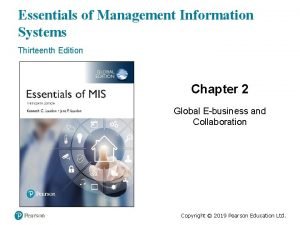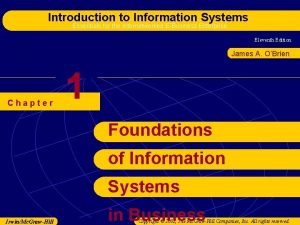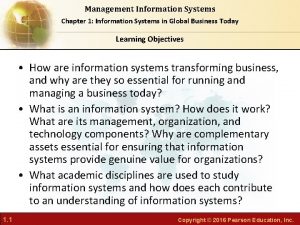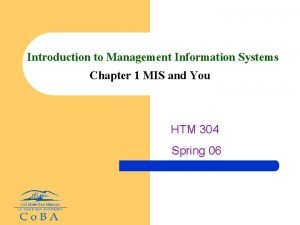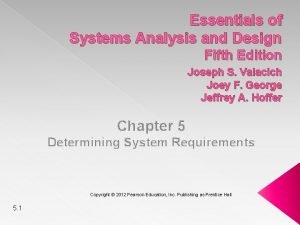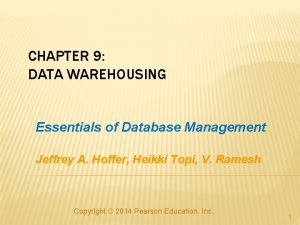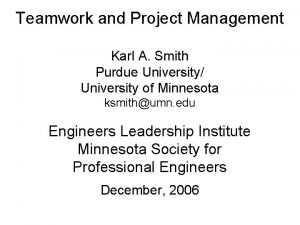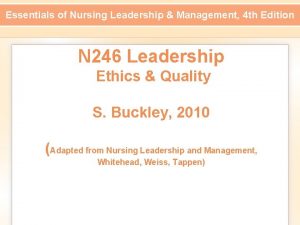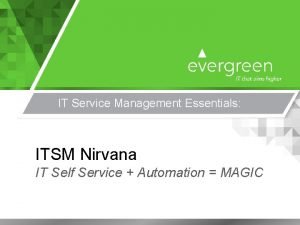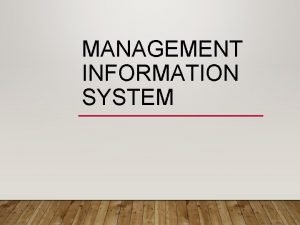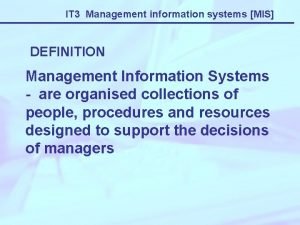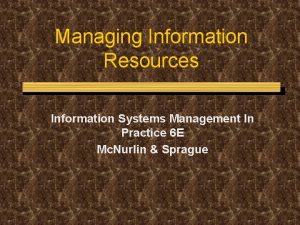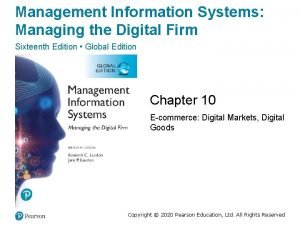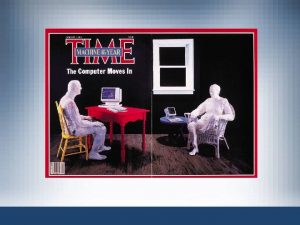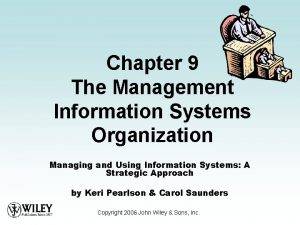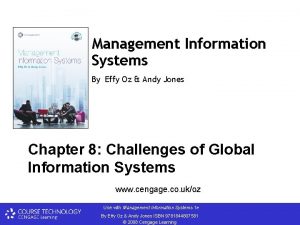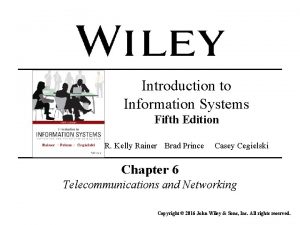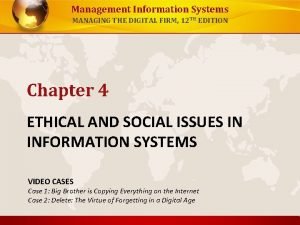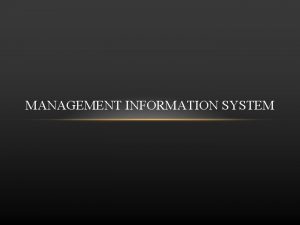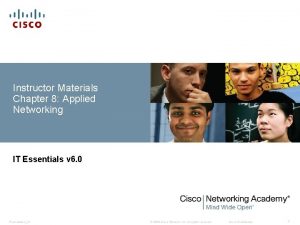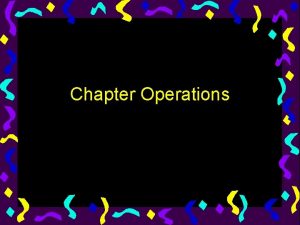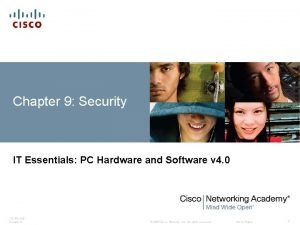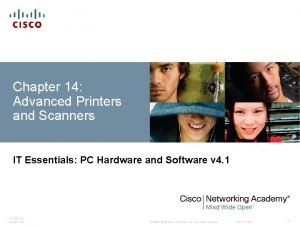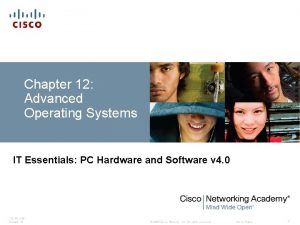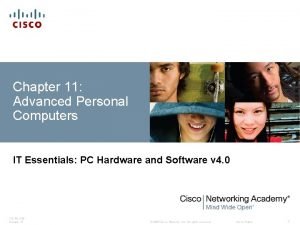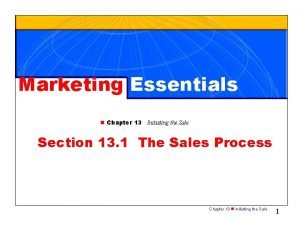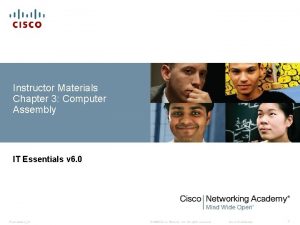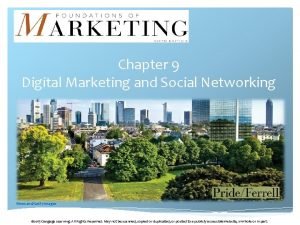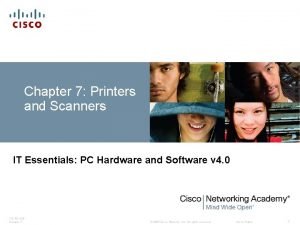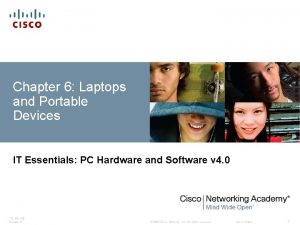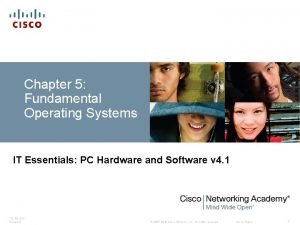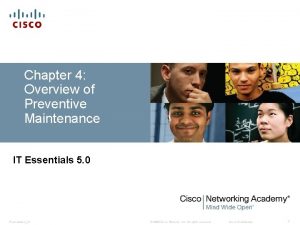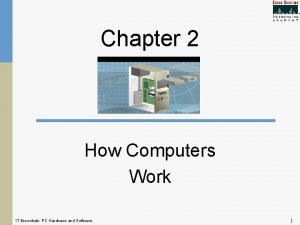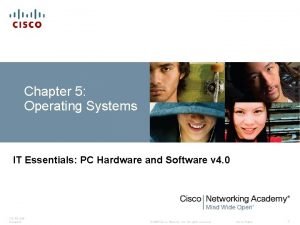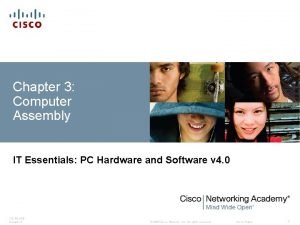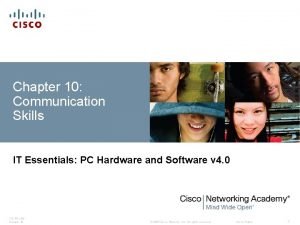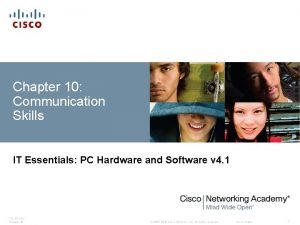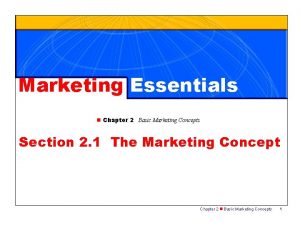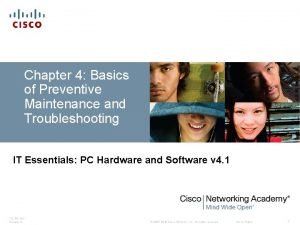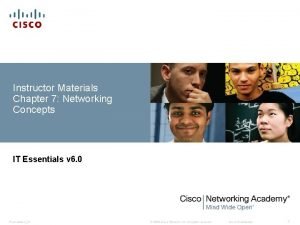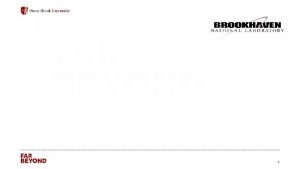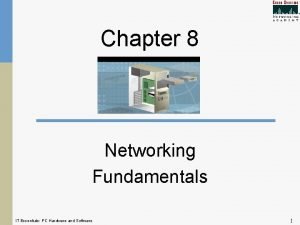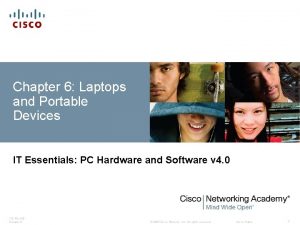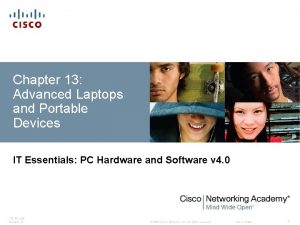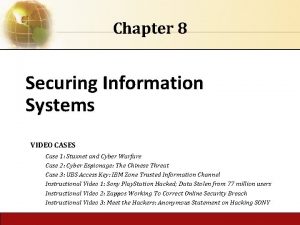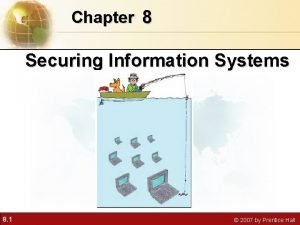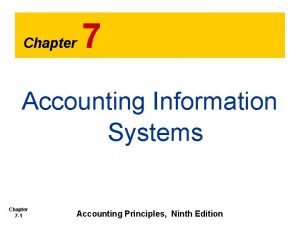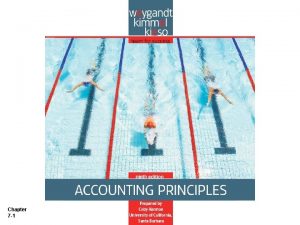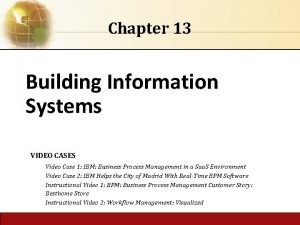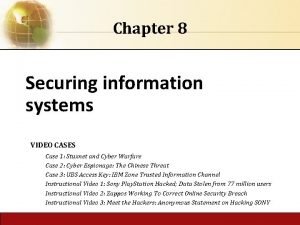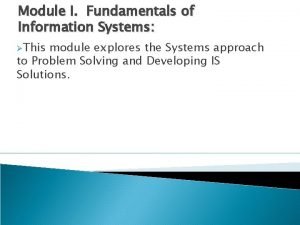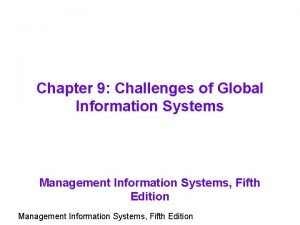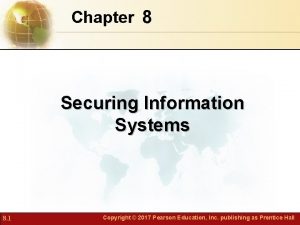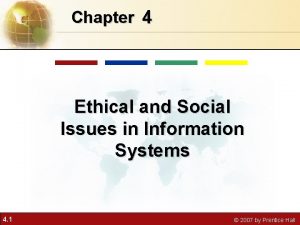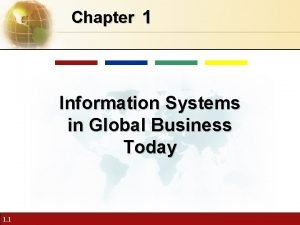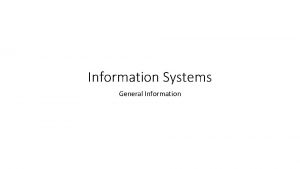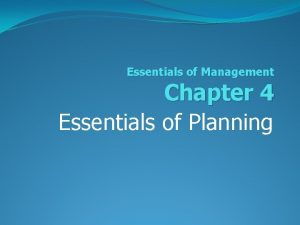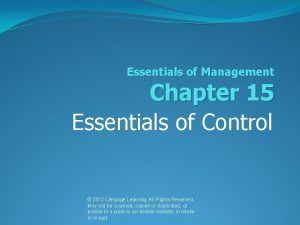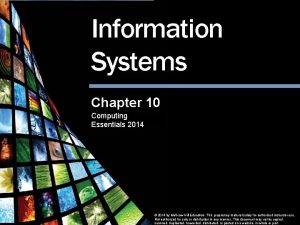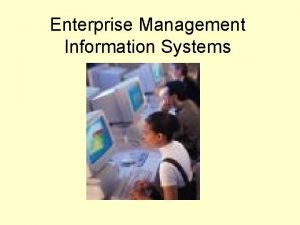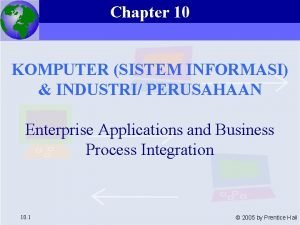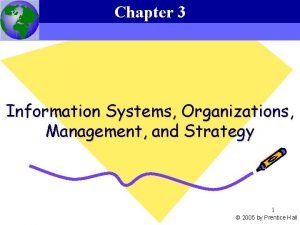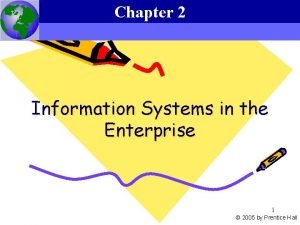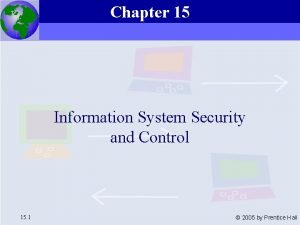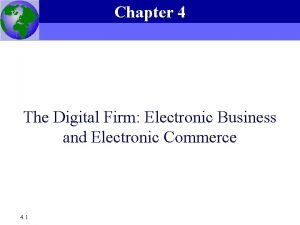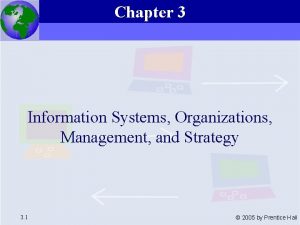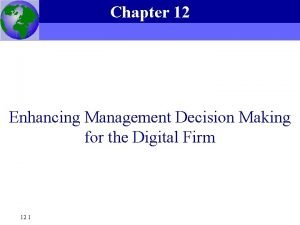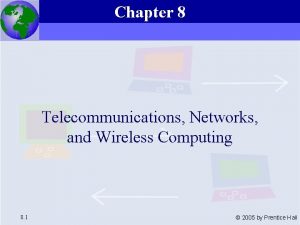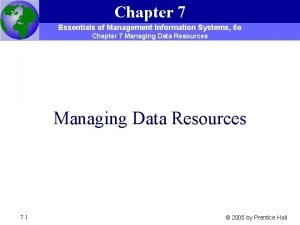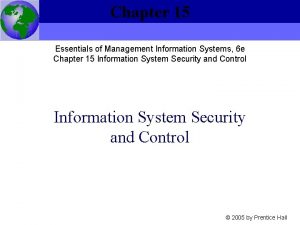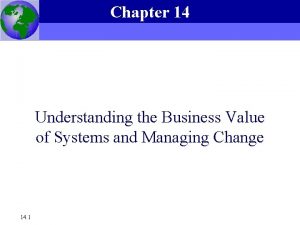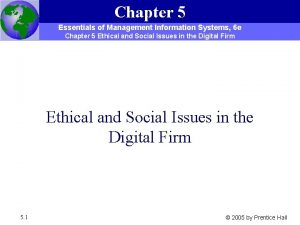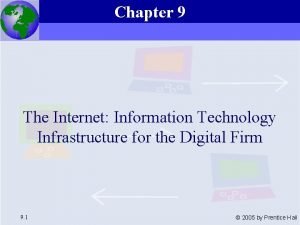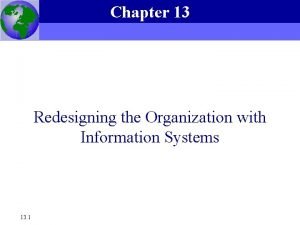Chapter 6 Essentials of Management Information Systems 6


















































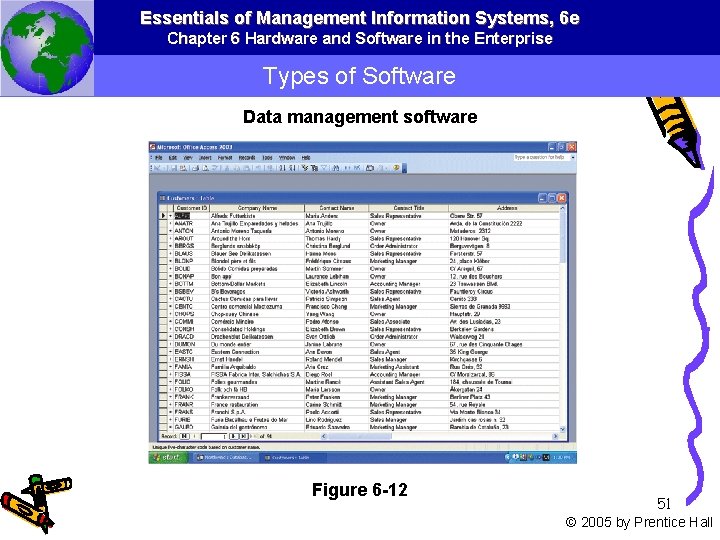
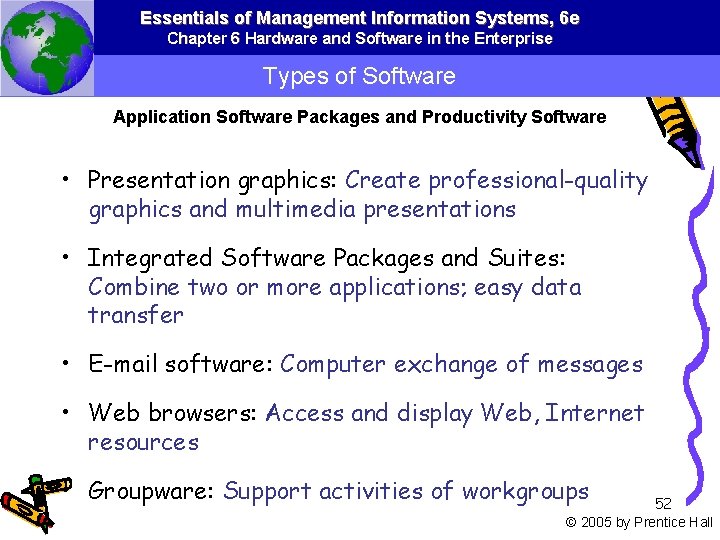
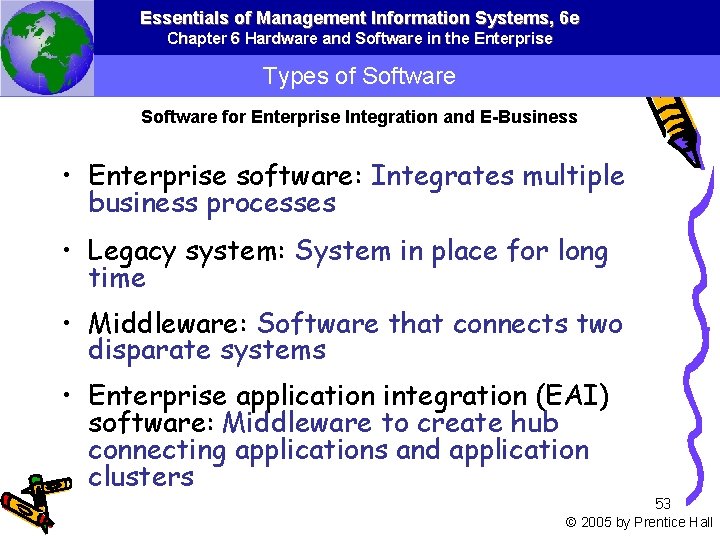
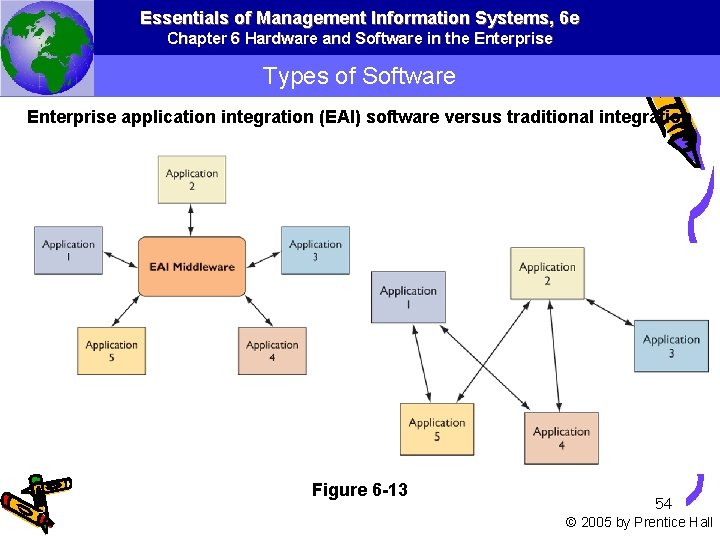
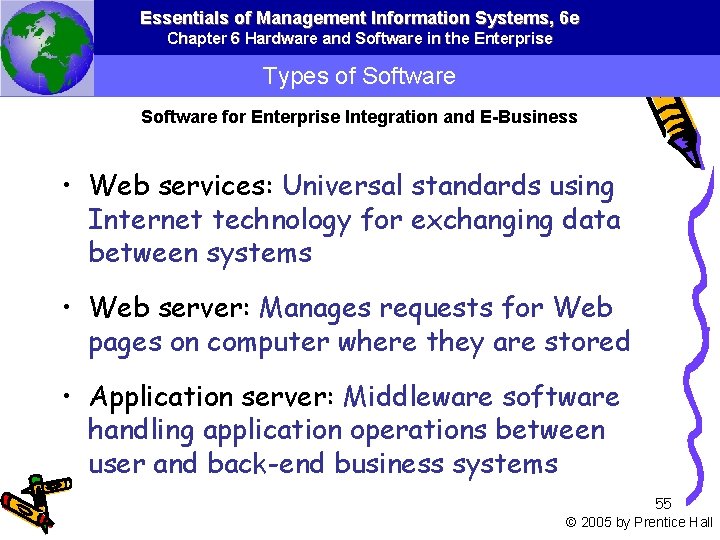
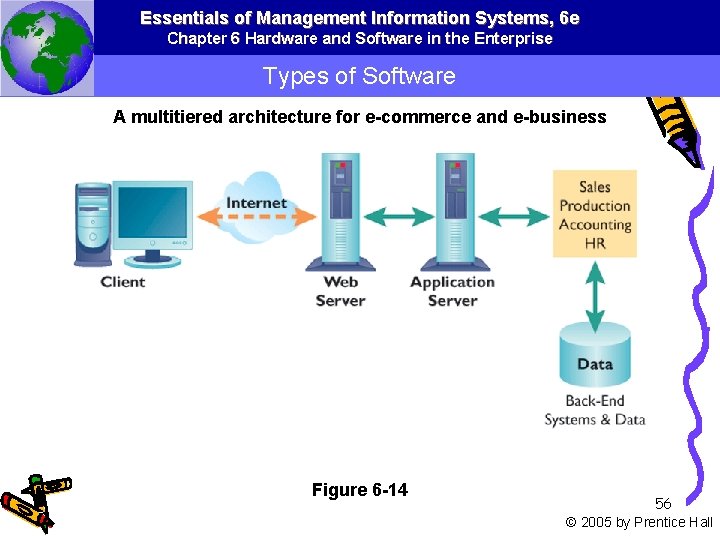
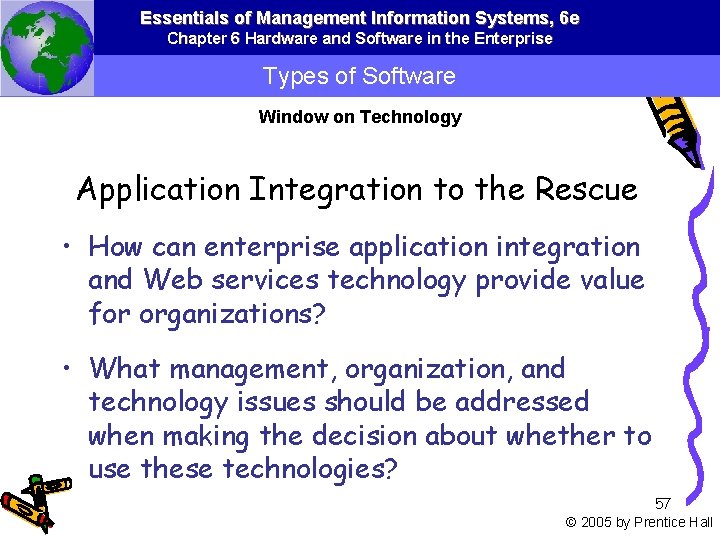
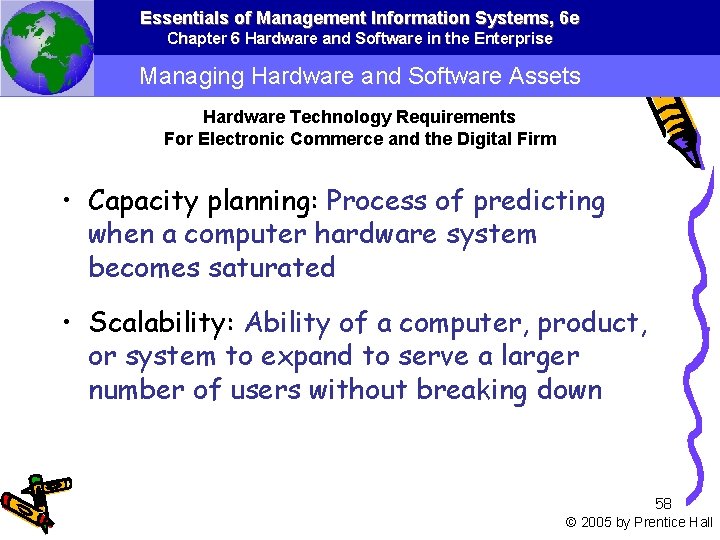
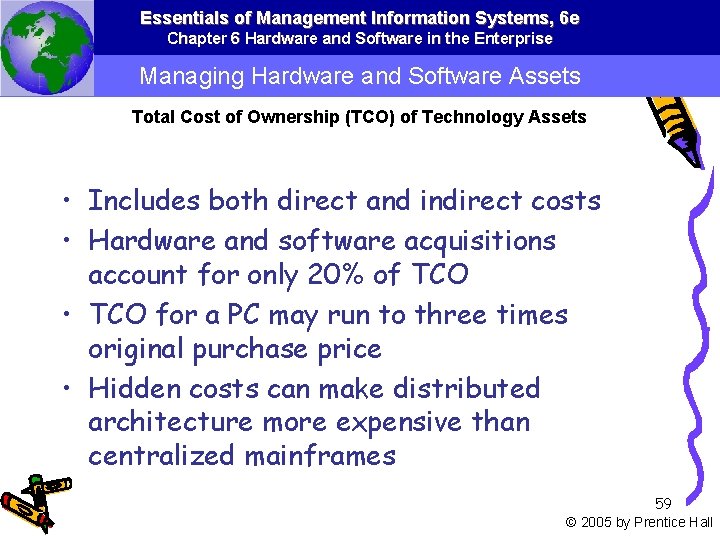
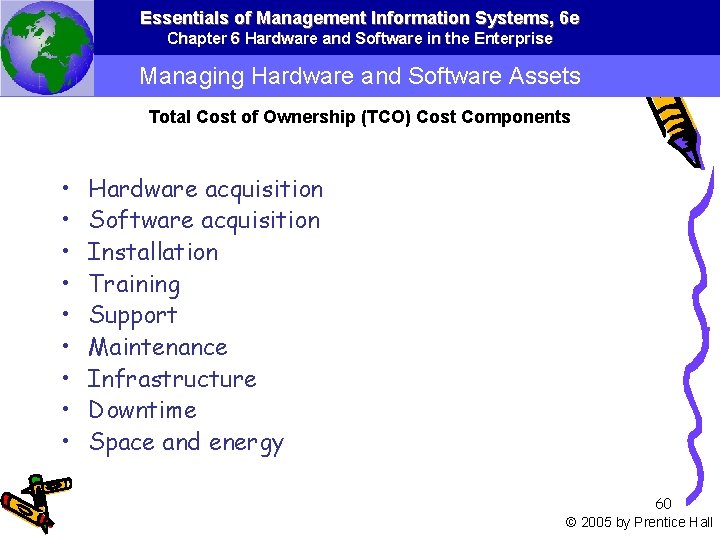
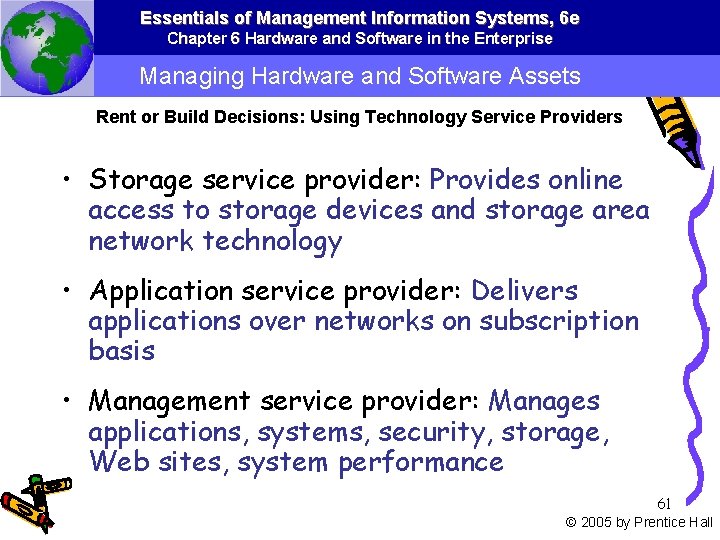
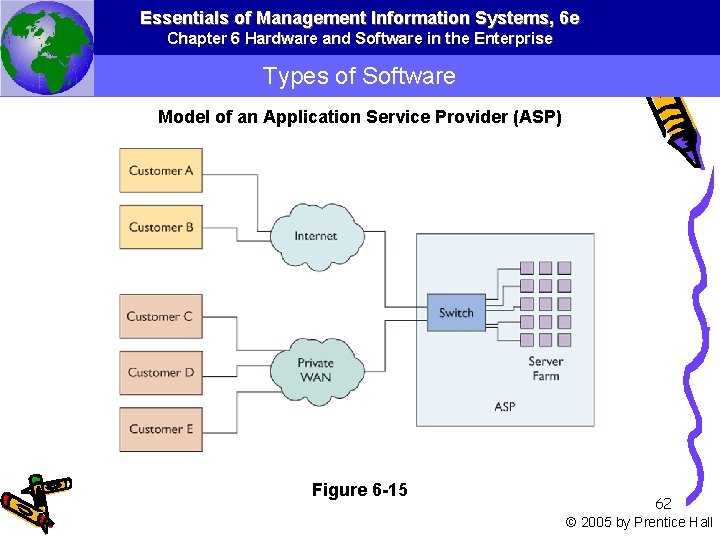
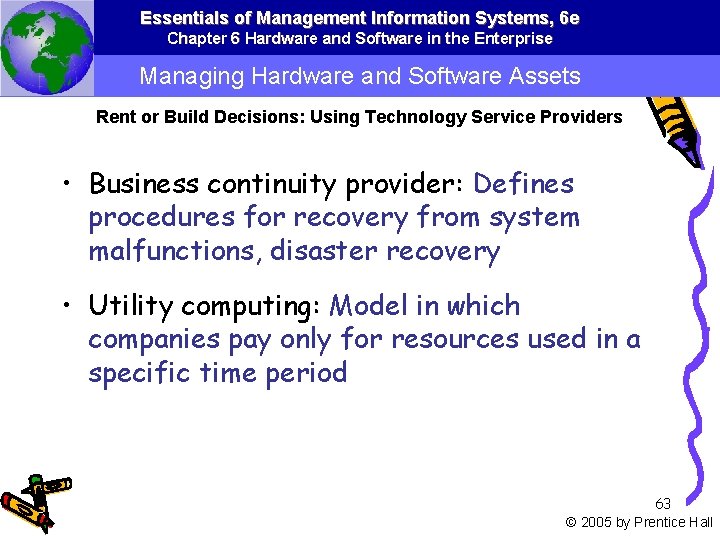
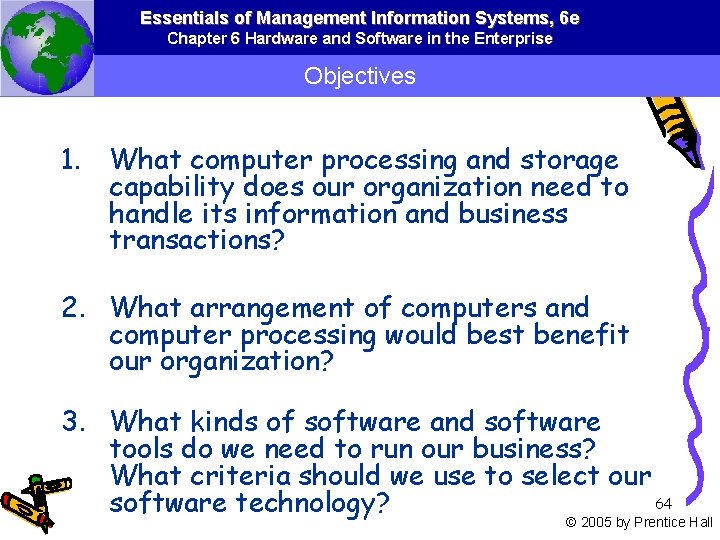
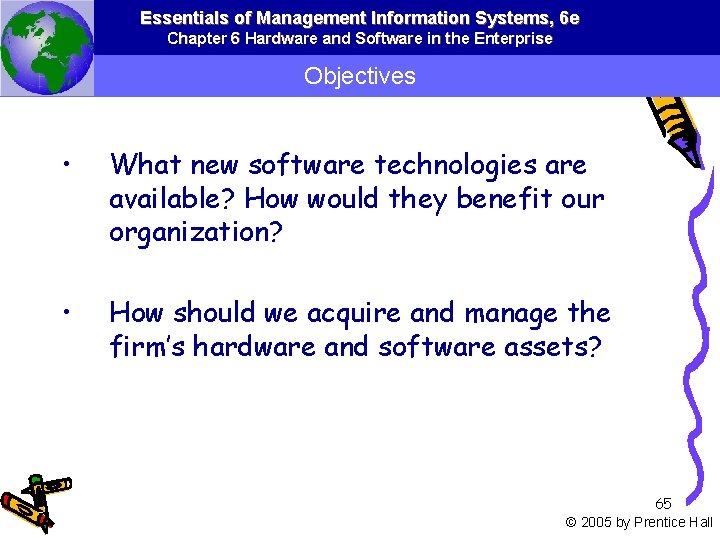
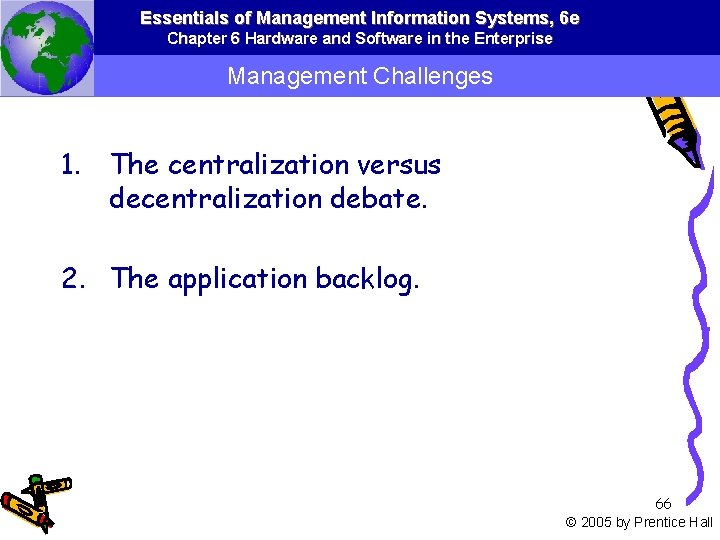
- Slides: 66

Chapter 6 Essentials of Management Information Systems, 6 e Chapter 6 Hardware and Software in the Enterprise 1 © 2005 by Prentice Hall


Essentials of Management Information Systems, 6 e Chapter 6 Hardware and Software in the Enterprise 企业信息基础构成示意 3 © 2005 by Prentice Hall







Essentials of Management Information Systems, 6 e Chapter 6 Hardware and Software in the Enterprise Computer Hardware and Information Technology Infrastructure Hardware components of a computer system Figure 6 -1 10 © 2005 by Prentice Hall

Essentials of Management Information Systems, 6 e Chapter 6 Hardware and Software in the Enterprise Computer Hardware and Information Technology Infrastructure The Computer System Bit • Binary digit • Represents 0 or 1 Byte • String of eight bits • Stores one number, symbol, character, part of picture 11 © 2005 by Prentice Hall

Essentials of Management Information Systems, 6 e Chapter 6 Hardware and Software in the Enterprise Computer Hardware and Information Technology Infrastructure Bits and bytes Figure 6 -2 12 © 2005 by Prentice Hall

Essentials of Management Information Systems, 6 e Chapter 6 Hardware and Software in the Enterprise Computer Hardware and Information Technology Infrastructure The Computer System The Central Processing Unit (CPU) • Controls other parts of computer • Arithmetic-logic unit performs principle logical/mathematical operations • Control unit coordinates other parts, such as reading a stored program 13 © 2005 by Prentice Hall

Essentials of Management Information Systems, 6 e Chapter 6 Hardware and Software in the Enterprise Computer Hardware and Information Technology Infrastructure The Computer System Primary Storage • Located near CPU • Stores all or part of active software program • Stores operating system software • Stores data the program is using 14 © 2005 by Prentice Hall

Essentials of Management Information Systems, 6 e Chapter 6 Hardware and Software in the Enterprise Computer Hardware and Information Technology Infrastructure The Computer System Primary Storage • Composed of semi-conductors • RAM (random access memory): Used for short-term, temporary storage • ROM (read-only memory): Semiconductor memory chips with program instructions 15 © 2005 by Prentice Hall

Essentials of Management Information Systems, 6 e Chapter 6 Hardware and Software in the Enterprise Computer Hardware and Information Technology Infrastructure The CPU and primary storage Figure 6 -3 16 © 2005 by Prentice Hall

Essentials of Management Information Systems, 6 e Chapter 6 Hardware and Software in the Enterprise Computer Hardware and Information Technology Infrastructure Computer Processing Microprocessors • Semiconductor chips integrate memory, logic, and control circuits for entire CPU • Speed depends on number of bits processed at one time; amount of data that can be moved between devices; and cycle speed (MHz) • RISC (reduced instruction set computing) increases speed; used for scientific, workstation computing 17 © 2005 by Prentice Hall

Essentials of Management Information Systems, 6 e Chapter 6 Hardware and Software in the Enterprise Computer Hardware and Information Technology Infrastructure Computer Processing Parallel processing • Multiple CPUs work simultaneously on same problem • More than one instruction processed at a time • Massively parallel computers: use hundreds, thousands of processing chips 18 © 2005 by Prentice Hall

Essentials of Management Information Systems, 6 e Chapter 6 Hardware and Software in the Enterprise Computer Hardware and Information Technology Infrastructure Sequential and parallel processing Figure 6 -4 19 © 2005 by Prentice Hall

Essentials of Management Information Systems, 6 e Chapter 6 Hardware and Software in the Enterprise Computer Hardware and Information Technology Infrastructure Storage, Input, and Output Technology Secondary Storage Technology • Used for relatively long-term storage of data outside CPU • Magnetic disk: floppies, hard disks, RAID • Optical disk: CD-ROM, CD-RW, DVD • Magnetic tape • Storage networking: direct-attached storage; network-attached storage; storage area networks 20 © 2005 by Prentice Hall

Essentials of Management Information Systems, 6 e Chapter 6 Hardware and Software in the Enterprise Computer Hardware and Information Technology Infrastructure A storage area network (SAN) Figure 6 -5 21 © 2005 by Prentice Hall

Essentials of Management Information Systems, 6 e Chapter 6 Hardware and Software in the Enterprise Computer Hardware and Information Technology Infrastructure Storage, Input, and Output Technology Input Devices • • • Keyboard and mouse Touch screen Optical character recognition Magnetic ink character recognition (MICR) Pen-based input Digital scanner Audio input Sensors Radio-frequency identification (RFID) 22 © 2005 by Prentice Hall

Essentials of Management Information Systems, 6 e Chapter 6 Hardware and Software in the Enterprise Computer Hardware and Information Technology Infrastructure Storage, Input, and Output Technology Output Devices • Cathode-ray tube (CRT) • Printers • Audio output 23 © 2005 by Prentice Hall

Essentials of Management Information Systems, 6 e Chapter 6 Hardware and Software in the Enterprise Computer Hardware and Information Technology Infrastructure Storage, Input, and Output Technology Batch Processing • Accumulates and stores transactions in group or batch until time to process them • Found primarily in older systems for occasional reporting • Use tape storage Online Processing • Transactions processed immediately • Use disk storage 24 © 2005 by Prentice Hall

Essentials of Management Information Systems, 6 e Chapter 6 Hardware and Software in the Enterprise Computer Hardware and Information Technology Infrastructure Storage, Input, and Output Technology Interactive Multimedia • Integrates sound, video or animation, graphics, text into computer-based application • Streaming technology • New compression standards: MP 3 (MPEG 3) 25 © 2005 by Prentice Hall

Essentials of Management Information Systems, 6 e Chapter 6 Hardware and Software in the Enterprise Categories of Computers and Computer Systems Classifying Computers • Mainframe: Largest computer; handles massive amounts of data; used for large business, scientific, military applications • Midrange computer: Smaller, less expensive minicomputers or servers; used for smaller organizations or managing networks • Minicomputers: Used in systems for universities, factories, research labs • Servers: Manage internal company networks or Web sites 26 © 2005 by Prentice Hall

Essentials of Management Information Systems, 6 e Chapter 6 Hardware and Software in the Enterprise Categories of Computers and Computer Systems Classifying Computers • Personal computer: Portable or desktop microcomputer • Workstation: More powerful desktop computer used for computation-intense tasks • Supercomputer: Sophisticated, powerful computer used for tasks requiring rapid, complex calculations; weapons research, weather forecasting 27 © 2005 by Prentice Hall

Essentials of Management Information Systems, 6 e Chapter 6 Hardware and Software in the Enterprise Categories of Computers and Computer Systems Computer Networks and Client/Server Computing • Distributed processing: Distribution of processing work among multiple computers • Centralized processing: Accomplished by one large central computer • Client/server computing: Splits processing between “clients” and “servers” on network 28 © 2005 by Prentice Hall

Essentials of Management Information Systems, 6 e Chapter 6 Hardware and Software in the Enterprise Categories of Computers and Computer Systems Client/server computing Figure 6 -6 29 © 2005 by Prentice Hall

Essentials of Management Information Systems, 6 e Chapter 6 Hardware and Software in the Enterprise Categories of Computers and Computer Systems Types of client/server computing Figure 6 -7 30 © 2005 by Prentice Hall

Essentials of Management Information Systems, 6 e Chapter 6 Hardware and Software in the Enterprise Categories of Computers and Computer Systems Network Computers and Peer-to-Peer Computing • Network computer (NC): Simplified desktop computer, does not store data permanently • Peer-to-peer computing: Distributed processing that links computers through Internet or private networks • Grid computing: Applies computational resources of many networked computers to solve a large, complex problem 31 © 2005 by Prentice Hall

Essentials of Management Information Systems, 6 e Chapter 6 Hardware and Software in the Enterprise Types of Software • Software program: A series of statements or instructions to the computer • Two major types of software: System software and application software • System software: Generalized programs that manage the computer’s resources • Application software: Programs written for or by users to perform a specific task 32 © 2005 by Prentice Hall

Essentials of Management Information Systems, 6 e Chapter 6 Hardware and Software in the Enterprise Types of Software The major types of software Figure 6 -8 33 © 2005 by Prentice Hall

Essentials of Management Information Systems, 6 e Chapter 6 Hardware and Software in the Enterprise Types of Software System Software and PC Operating Systems • Operating system software: Manages the computer system, resources; controls memory, input, output, and task scheduling • Computer language translation programs: Compiles source code of high-level language programs (C, FORTRAN) into object code - machine language the computer can execute • Utility programs: Perform routine, repetitive tasks such as copying, clearing primary storage 34 © 2005 by Prentice Hall

Essentials of Management Information Systems, 6 e Chapter 6 Hardware and Software in the Enterprise Types of Software System Software and PC Operating Systems Operating System Capabilities • Multiprogramming: Concurrent use of CPU by multiple programs • Virtual storage: Breaks programs into smaller portions to read as needed • Time-sharing: Allows many users to share CPU time • Multi-processing: Links two or more CPUs to work in parallel in single computer system 35 © 2005 by Prentice Hall

Essentials of Management Information Systems, 6 e Chapter 6 Hardware and Software in the Enterprise Types of Software System Software and PC Operating Systems • Software written for one OS generally cannot run on another • Graphical User Interface (GUI): Dominant model for user interface for operating systems and applications 36 © 2005 by Prentice Hall

Essentials of Management Information Systems, 6 e Chapter 6 Hardware and Software in the Enterprise Types of Software System Software and PC Operating Systems Leading PC Operating Systems • • • Windows XP Windows 2000 Windows Server 2003 Windows 98/ME Windows CE Unix Linux Mac OS DOS 37 © 2005 by Prentice Hall

Essentials of Management Information Systems, 6 e Chapter 6 Hardware and Software in the Enterprise Types of Software Window on Management The Case for Linux • Should a company select Linux as an operating system for its major business applications? • What are the management benefits Linux provides? • What are the business as well as the technology issues that should be addressed when making that decision? 38 © 2005 by Prentice Hall

Essentials of Management Information Systems, 6 e Chapter 6 Hardware and Software in the Enterprise Types of Software Application Programming Languages Machine language 1 st generation; binary C Operating systems; application software C++ Object-oriented; application software COBOL Business administration; alphanumeric processing Visual Basic Visual tool; Windows applications 39 © 2005 by Prentice Hall

Essentials of Management Information Systems, 6 e Chapter 6 Hardware and Software in the Enterprise Types of Software Application Programming Languages FORTRAN Processing numeric data; scientific, engineering programs BASIC Used for teaching Pascal Used primarily for teaching programming Second generation; close to machine language; system software Assembly language 40 © 2005 by Prentice Hall

Essentials of Management Information Systems, 6 e Chapter 6 Hardware and Software in the Enterprise Types of Software Programming Languages and Contemporary Software Tools • Fourth generation languages: Enable end users to develop applications with minimal or no assistance; less procedural • Procedural languages: Require sequence of steps • Nonprocedural languages: Specify tasks but not details on sequence • Natural languages: Nonprocedural languages resembling human speech • Query languages: Software tools for providing online answers to information requests 41 © 2005 by Prentice Hall

Essentials of Management Information Systems, 6 e Chapter 6 Hardware and Software in the Enterprise Types of Software Categories of Fourth-Generation Languages PC software tools General-purpose packages Word. Perfect, Microsoft Access Query language Retrieve data stored in databases or files SQL Report generator Retrieve data, more formatting control; Crystal Reports Graphics language Retrieve data, graphics format SAS Graph; Systat 42 © 2005 by Prentice Hall

Essentials of Management Information Systems, 6 e Chapter 6 Hardware and Software in the Enterprise Types of Software Categories of Fourth-Generation Languages Application generator Preprogrammed modules FOCUS, Microsoft Front. Page Application software package Commercial software replacing need for custom, in-house software People. Soft HCM, SAP R/3 Very high-level programming language Generate code with fewer instructions; productivity tool for programmers APL, Nomad 2 43 © 2005 by Prentice Hall

Essentials of Management Information Systems, 6 e Chapter 6 Hardware and Software in the Enterprise Types of Software Programming Languages and Contemporary Software Tools Object-Oriented Programming • Combine data and methods (procedures) into one object • Objects are independent, reusable building blocks • Based on concepts of class and inheritance 44 © 2005 by Prentice Hall

Essentials of Management Information Systems, 6 e Chapter 6 Hardware and Software in the Enterprise Types of Software Class and inheritance Figure 6 -9 45 © 2005 by Prentice Hall

Essentials of Management Information Systems, 6 e Chapter 6 Hardware and Software in the Enterprise Types of Software Programming Languages and Contemporary Software Tools Java • Object-oriented • Platform-independent • Robust; handles data, graphics, video, sound • Can create “applets”; often used on Web • Java applications tend to run slower than “native” programs 46 © 2005 by Prentice Hall

Essentials of Management Information Systems, 6 e Chapter 6 Hardware and Software in the Enterprise Types of Software Programming Languages and Contemporary Software Tools • Hypertext Markup Language (HTML): Page description language; creates Web pages and other hypermedia documents • XML (e. Xtensible Markup Language): Describes the structure of a document; provides standard format for data exchange • XHTML: Reformulates HTML with XML document-type definitions 47 © 2005 by Prentice Hall

Essentials of Management Information Systems, 6 e Chapter 6 Hardware and Software in the Enterprise Types of Software Application Software Packages and Productivity Software • Word processing software: Create, format, print documents • Desktop publishing software: Produce professional -quality documents with greater formatting, design capabilities • Spreadsheets: Display data in grid for recalculating numerical data • Data management software: Store, manipulate data in lists and databases 48 © 2005 by Prentice Hall

Essentials of Management Information Systems, 6 e Chapter 6 Hardware and Software in the Enterprise Types of Software Text and the spell-checking option in Microsoft Word Figure 6 -10 49 © 2005 by Prentice Hall

Essentials of Management Information Systems, 6 e Chapter 6 Hardware and Software in the Enterprise Types of Software Spreadsheet software Figure 6 -11 50 © 2005 by Prentice Hall

Essentials of Management Information Systems, 6 e Chapter 6 Hardware and Software in the Enterprise Types of Software Data management software Figure 6 -12 51 © 2005 by Prentice Hall

Essentials of Management Information Systems, 6 e Chapter 6 Hardware and Software in the Enterprise Types of Software Application Software Packages and Productivity Software • Presentation graphics: Create professional-quality graphics and multimedia presentations • Integrated Software Packages and Suites: Combine two or more applications; easy data transfer • E-mail software: Computer exchange of messages • Web browsers: Access and display Web, Internet resources • Groupware: Support activities of workgroups 52 © 2005 by Prentice Hall

Essentials of Management Information Systems, 6 e Chapter 6 Hardware and Software in the Enterprise Types of Software for Enterprise Integration and E-Business • Enterprise software: Integrates multiple business processes • Legacy system: System in place for long time • Middleware: Software that connects two disparate systems • Enterprise application integration (EAI) software: Middleware to create hub connecting applications and application clusters 53 © 2005 by Prentice Hall

Essentials of Management Information Systems, 6 e Chapter 6 Hardware and Software in the Enterprise Types of Software Enterprise application integration (EAI) software versus traditional integration Figure 6 -13 54 © 2005 by Prentice Hall

Essentials of Management Information Systems, 6 e Chapter 6 Hardware and Software in the Enterprise Types of Software for Enterprise Integration and E-Business • Web services: Universal standards using Internet technology for exchanging data between systems • Web server: Manages requests for Web pages on computer where they are stored • Application server: Middleware software handling application operations between user and back-end business systems 55 © 2005 by Prentice Hall

Essentials of Management Information Systems, 6 e Chapter 6 Hardware and Software in the Enterprise Types of Software A multitiered architecture for e-commerce and e-business Figure 6 -14 56 © 2005 by Prentice Hall

Essentials of Management Information Systems, 6 e Chapter 6 Hardware and Software in the Enterprise Types of Software Window on Technology Application Integration to the Rescue • How can enterprise application integration and Web services technology provide value for organizations? • What management, organization, and technology issues should be addressed when making the decision about whether to use these technologies? 57 © 2005 by Prentice Hall

Essentials of Management Information Systems, 6 e Chapter 6 Hardware and Software in the Enterprise Managing Hardware and Software Assets Hardware Technology Requirements For Electronic Commerce and the Digital Firm • Capacity planning: Process of predicting when a computer hardware system becomes saturated • Scalability: Ability of a computer, product, or system to expand to serve a larger number of users without breaking down 58 © 2005 by Prentice Hall

Essentials of Management Information Systems, 6 e Chapter 6 Hardware and Software in the Enterprise Managing Hardware and Software Assets Total Cost of Ownership (TCO) of Technology Assets • Includes both direct and indirect costs • Hardware and software acquisitions account for only 20% of TCO • TCO for a PC may run to three times original purchase price • Hidden costs can make distributed architecture more expensive than centralized mainframes 59 © 2005 by Prentice Hall

Essentials of Management Information Systems, 6 e Chapter 6 Hardware and Software in the Enterprise Managing Hardware and Software Assets Total Cost of Ownership (TCO) Cost Components • • • Hardware acquisition Software acquisition Installation Training Support Maintenance Infrastructure Downtime Space and energy 60 © 2005 by Prentice Hall

Essentials of Management Information Systems, 6 e Chapter 6 Hardware and Software in the Enterprise Managing Hardware and Software Assets Rent or Build Decisions: Using Technology Service Providers • Storage service provider: Provides online access to storage devices and storage area network technology • Application service provider: Delivers applications over networks on subscription basis • Management service provider: Manages applications, systems, security, storage, Web sites, system performance 61 © 2005 by Prentice Hall

Essentials of Management Information Systems, 6 e Chapter 6 Hardware and Software in the Enterprise Types of Software Model of an Application Service Provider (ASP) Figure 6 -15 62 © 2005 by Prentice Hall

Essentials of Management Information Systems, 6 e Chapter 6 Hardware and Software in the Enterprise Managing Hardware and Software Assets Rent or Build Decisions: Using Technology Service Providers • Business continuity provider: Defines procedures for recovery from system malfunctions, disaster recovery • Utility computing: Model in which companies pay only for resources used in a specific time period 63 © 2005 by Prentice Hall

Essentials of Management Information Systems, 6 e Chapter 6 Hardware and Software in the Enterprise Objectives 1. What computer processing and storage capability does our organization need to handle its information and business transactions? 2. What arrangement of computers and computer processing would best benefit our organization? 3. What kinds of software and software tools do we need to run our business? What criteria should we use to select our 64 software technology? © 2005 by Prentice Hall

Essentials of Management Information Systems, 6 e Chapter 6 Hardware and Software in the Enterprise Objectives • What new software technologies are available? How would they benefit our organization? • How should we acquire and manage the firm’s hardware and software assets? 65 © 2005 by Prentice Hall

Essentials of Management Information Systems, 6 e Chapter 6 Hardware and Software in the Enterprise Management Challenges 1. The centralization versus decentralization debate. 2. The application backlog. 66 © 2005 by Prentice Hall
 Essentials of management information systems
Essentials of management information systems Essentials of information systems
Essentials of information systems Management information system chapter 1
Management information system chapter 1 Introduction to mis
Introduction to mis Essentials of systems analysis and design
Essentials of systems analysis and design Essentials of migration management
Essentials of migration management Data warehouse essentials
Data warehouse essentials Purdue project management
Purdue project management Essentials of migration management
Essentials of migration management Essentials of nursing leadership & management
Essentials of nursing leadership & management Essentials of migration management
Essentials of migration management Service management essentials
Service management essentials Examples of management information systems
Examples of management information systems Management information systems (mis)
Management information systems (mis) Information systems management in practice
Information systems management in practice Management information systems 16th edition
Management information systems 16th edition Specialized information systems
Specialized information systems Management information systems wiley
Management information systems wiley Management information systems effy oz
Management information systems effy oz Introduction to management information systems 5th edition
Introduction to management information systems 5th edition Management information systems managing the digital firm
Management information systems managing the digital firm Mis meaning
Mis meaning It essentials chapter 8
It essentials chapter 8 What are the essentials of a successful ffa chapter
What are the essentials of a successful ffa chapter It essential chapter 9
It essential chapter 9 It essentials
It essentials It essentials chapter 12
It essentials chapter 12 It essential chapter 11
It essential chapter 11 Business essentials 12th edition chapter 1
Business essentials 12th edition chapter 1 Marketing essentials chapter 38
Marketing essentials chapter 38 Chapter 13 initiating the sale answer key
Chapter 13 initiating the sale answer key How is form utility not related to marketing
How is form utility not related to marketing It essentials chapter 5
It essentials chapter 5 It essentials chapter 3
It essentials chapter 3 It essentials chapter 11
It essentials chapter 11 Essentials of social media marketing chapter 9 quiz
Essentials of social media marketing chapter 9 quiz It essentials chapter 7
It essentials chapter 7 It essentials chapter 6
It essentials chapter 6 It essentials chapter 5
It essentials chapter 5 It essentials chapter 4
It essentials chapter 4 Chapter 4 kitchen essentials 1 answers
Chapter 4 kitchen essentials 1 answers It essentials chapter 2
It essentials chapter 2 It essentials chapter 5
It essentials chapter 5 It essentials chapter 3
It essentials chapter 3 It essentials chapter 10
It essentials chapter 10 It essentials chapter 10
It essentials chapter 10 Meeting jesus in the sacraments chapter 1 crossword
Meeting jesus in the sacraments chapter 1 crossword Marketing essentials chapter 2
Marketing essentials chapter 2 Preventive maintenance and troubleshooting
Preventive maintenance and troubleshooting It essentials chapter 7
It essentials chapter 7 What are the ten essentials of a successful ffa chapter
What are the ten essentials of a successful ffa chapter What copper cored cable is surrounded by a heavy shielding
What copper cored cable is surrounded by a heavy shielding It essentials chapter 6
It essentials chapter 6 Chapter 5 kitchen essentials 2
Chapter 5 kitchen essentials 2 It essentials chapter 13
It essentials chapter 13 Chapter 8 securing information systems
Chapter 8 securing information systems Chapter 8 securing information systems
Chapter 8 securing information systems Chapter 7 accounting information systems
Chapter 7 accounting information systems Chapter 7 accounting information systems
Chapter 7 accounting information systems Dfd ch 13
Dfd ch 13 Chapter 8 securing information systems
Chapter 8 securing information systems Introduction to information systems 6th edition
Introduction to information systems 6th edition Fundamentals of information systems
Fundamentals of information systems Obstacles to using global information systems
Obstacles to using global information systems Chapter 8 securing information systems
Chapter 8 securing information systems Chapter 4 ethical issues
Chapter 4 ethical issues Information systems in global business today
Information systems in global business today
